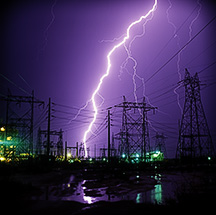Power Surge Protection – Do You Need It?
 How many of us have waited until our computer, television, or other electrical apparatus was zapped by a rogue current and it resulted in replacement or repair due to an electrical surge? If you were like many, you probably have a personal story to share with an audience that involved having just purchased a new computer or television, and not long after, it was affected by a power surge from an electrical storm rendering the unit virtually useless, and perhaps lost data. Needless to say it prompted you shortly thereafter to run to the nearest vendor and invest in a power surge protection unit.
How many of us have waited until our computer, television, or other electrical apparatus was zapped by a rogue current and it resulted in replacement or repair due to an electrical surge? If you were like many, you probably have a personal story to share with an audience that involved having just purchased a new computer or television, and not long after, it was affected by a power surge from an electrical storm rendering the unit virtually useless, and perhaps lost data. Needless to say it prompted you shortly thereafter to run to the nearest vendor and invest in a power surge protection unit.
Let’s talk about a power surge protector and what it exactly does for your electronic components. First of all, please don’t confuse the ubiquitous power strip with multiple outlet connections fulfilling the same role for protection…they are merely an extension cord with multiple outlets, nothing more, and offer no protection whatsoever against any type of hazardous electrical surge, induced or accidental. A power surge protector is designed to purposely protect your equipment from exposure to any random and uncontrollable electrical power surge by ensuring the current being supplied to the unit does not exceed the recommended voltage rating. Should an inadvertent or accidental power surge occur, the unit will protect all connecting equipment from being permanently damaged and disabled by discharging the rogue current into the ground connection at the outlet. Many contain a built in or replaceable fuse for additional protection.
The item is available in many designs, sizes, and prices ranging from as low as $15 up to $995. You’ll want to buy the best protection you can afford, after all, how many of us can afford to replace all our components? Many surge protection units such as APC, Monster, Phillips, and Belkin come with a connected equipment warranty ranging from $100,000 or more, to cover full replacement costs for all connected components in the event the unit ever fails due to a random power surge. The key word here is “connected”…the protection is of no value to the intended component if you’re not plugged into the surge protector unit. Some automatically disconnect power to all components and emit an alarm or have an indicator light to warn the individual of a transpired surge.
Nearly all power surge protectors provide secured connections for phone lines, Ethernet, coaxial (internet) cables, modems, and power cords. It is strongly recommended that you connect all cables and power cords to the unit for providing full maximum protection.
You may want to consider purchasing a battery backup surge protector to safeguard your computer against potential loss of data during a momentary loss of power as a result of an electrical storm or accidental power outage. The unit will ensure your computer has an uninterrupted power supply (from the battery) and permit you to safely power down while saving your data. It will hold its charge from 10 minutes to an hour, depending upon the unit features and costs. All peripherals (printers, backup storage, etc.) should be connected to avoid any potential damage and provide full protection.






